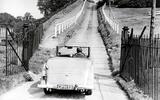Few phrases illustrate language’s evolution as succinctly as ‘road test’. Free from the constraints of its earlier, literal limitations, nowadays it’s applied to myriad scenarios where products or situations are sampled before making informed decisions about whether they warrant our commitment.
Over recent months we have witnessed smartphones, kettles and even databases being subjected to the notion of being ‘road tested’. Denominalisation’s march is relentless.
As the road test’s originators, Autocar defined the concept of reviewing cars in an as-standardised-as-possible manner, amplifying its readers’ ability to compare different models’ virtues, or lack of.
Combined with the series’ stoic longevity, its worthiness as a focus for a geeky reference work resonated with me, so a couple of years ago I began working on the Road Test Record.
Autocar cites 13 April 1928 as its road testing legacy’s commencement, making it the logical point from which to record data. But was it? Mining the online Autocar Archive’s depths confirmed those early Road Tests lacked sequential reference numbers: this development appeared 34 months later, in the 13 February 1931 issue, bearing the number 619.
Enjoy full access to the complete Autocar archive at themagazineshop.com
That sounded too high, but an editorial explainer confirmed an inconvenient truth: that 619 tally was the post-WW1 total, not only those since spring 1928.
Proving the 619 figure’s accuracy is impossible owing to a lack of definitive records, but nevertheless it became a fixed point from which to anchor the research, reasoning the series’ relative newness should prevent extreme discrepancies.
Title aside, pre-Road Test road tests employed one of two routes, including Brooklands when availability permitted, and featured stat-laden ‘Data for the Driver’ panels.
Scouring all post-Armistice issues, the 27 March 1920 review of Rover’s 8hp was the earliest one to tick all the relevant boxes, although reasonably persuasive cases could be argued for a brace of older examples. Had 618 unnumbered tests been revealed? No – 44 shy.
Combining research experience and fortuitous inspiration, I then included models recorded in occasionally published lists of recently tested cars that otherwise hadn’t met the applied criteria.











Add your comment